





Visit also the main downy mildew information page, & how to spot the other type of infection of downy mildew in leaves. You will also be interested in signs of systemic infection as plants emerge in spring.
Here we look at those plants that I believe are systemically affected, via the meristem. These are where new leaves appear infected as soon as they grow, they are a lighter, whiter green rather than having yellowy patches.
I also pictorially show how I have removed such leaves, hoping to save the plant. When the whole plant is affected in this way it may be impossible to save, and it needs to be dug out. However, sometimes only some 'noses' (shoots) are affected, & I hope other meristems will not be affected, so the plant just may survive.......
Signs of Downy Mildew in new Leaves |
||
| The out-of-focus leaf on left is fine, but what is happening
to the new leaves being produced at ground level? They are shown
closer-up in the far right photo. Sign 1 The whole new leaf is a lighter, whiter green. |
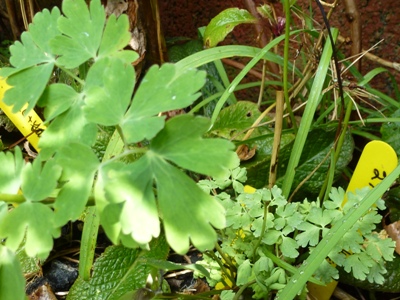 |
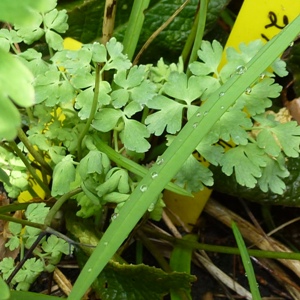 |
| Let's go closer. The leaves look frillier than the usual aquilegia leaves. The reasons for this are complex, and not easy to put into words, except that firstly: Sign 2 There is a more of a delicate maidenhair-fern effect, partly due to smaller lamina. More discussion is given in the final table of the web-page on biternate and triternate leaves. |
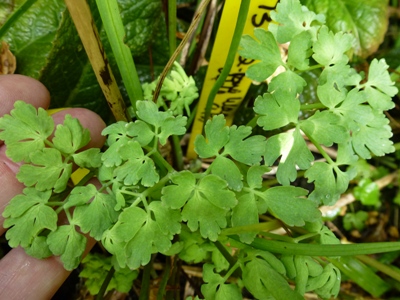 |
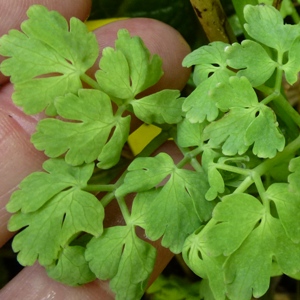 |
| Secondly: Sign 3 There is often a downward curling to the leaflets. |
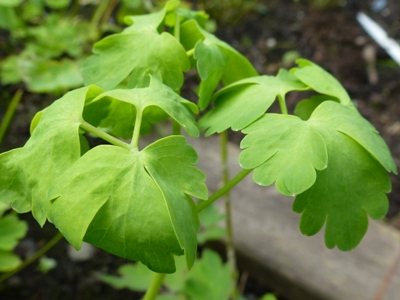 |
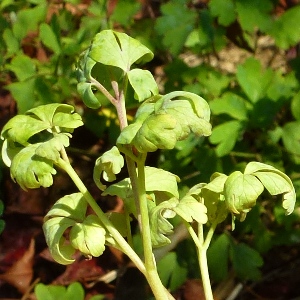 |
|
Or... Sign 3a Less often, (or possibly: later) there is an upward curling to the leaflets. |
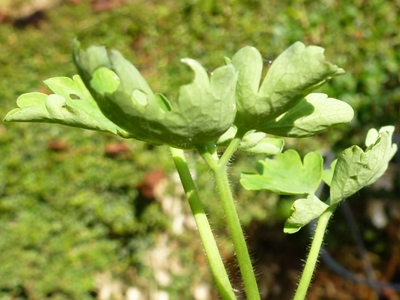 |
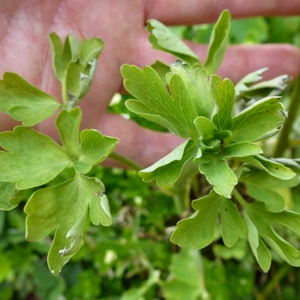 |
| This may also be a sign, I'm unsure as I do not let my
leaves/plants survive to this stage. Sign 4 (possible) The die-back of leaf tissue in these leaves is from the edge, inwards. Compared to the yellowy patches infection which starts within the patches. |
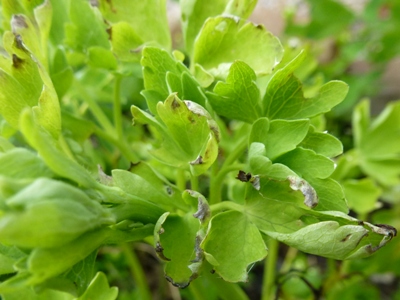 |
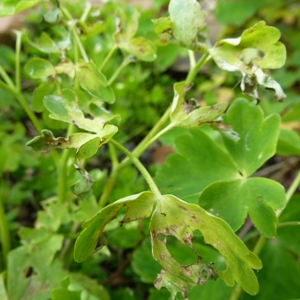 |
|
These affected new leaves grow differently from unaffected,
normal leaves. Remember,
the leaf stem (petiole) of aquilegias starts at ground level,
NOT where the leaf divides into leaflet. Sign 5 More upright growth of the petiole rather than angled at ground level. The angling / splaying, I assume, is a trophic response to gravity (&/or light) to allow maximum light to the leaf surface. Therefore, downy mildew affects plant growth pattern & movement. Note there are also flower stems in the photo, and they should grow upright. |
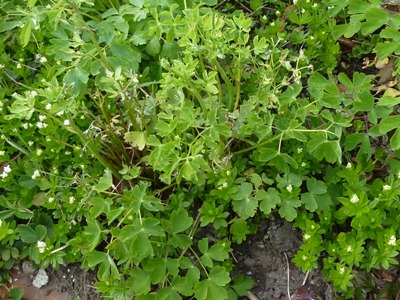 |
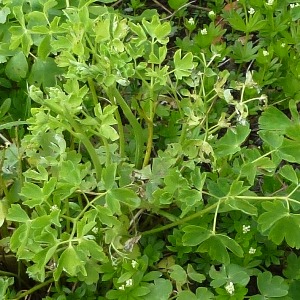 |
|
The length of the petiole compared to leaf surface area, is
longer in DM infected plants. This effect is mostly (or all) due
to a smaller lamina (leaf surface) Sign 6 Longer leaf petiole compared to leaf surface area. |
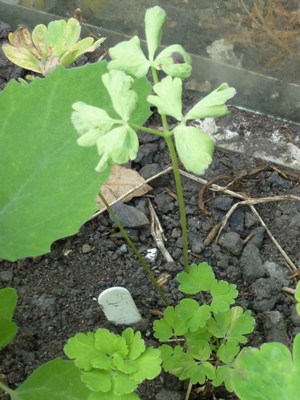 |
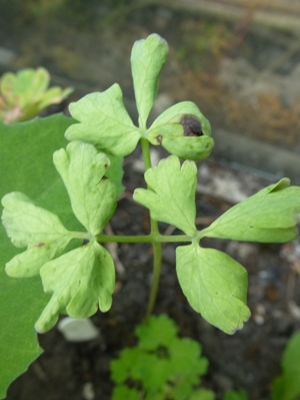 |
| What is the overall effect? How might you notice that
something is amiss with your plants? Sign 7 Overall the plant looks etiolated: lighter coloured, less leaf surface and drawn (longer petioles) as if there is not enough light. |
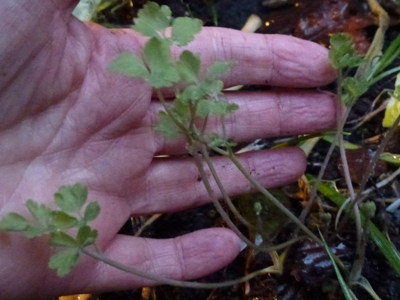 |
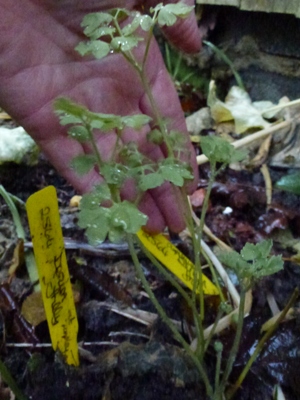 |
| Another way the whole plant may come to your attention is
due to the unusual curledness of the leaf which (especially with
the dying-back effect at the edges of leaves, and longer
petioles) makes it look distorted. Sign 7 continued Overall the plant may look distorted, sick and frazzled, or even blasted or blighted, perhaps looking as if it has been affected by frost (here in the UK that doesn't happen), or by weedkiller drift. This overall effect is exacerbated by the whitish leaf tone. |
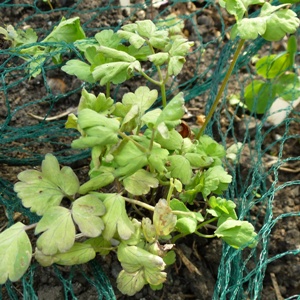 |
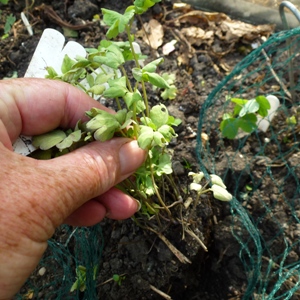 |
Example of an infected plant |
||
| Let's look at a dwarf ((20-30come, 8-12") Aquilegia, a blue
and white flowered plant from the Spring Magic range, in my
front garden. Main photo: The brother plant to the bottom right is fine, the top left plant is affected and shows the signs above, in particular looking (to me) etiolated, frazzled, sick and blighted. |
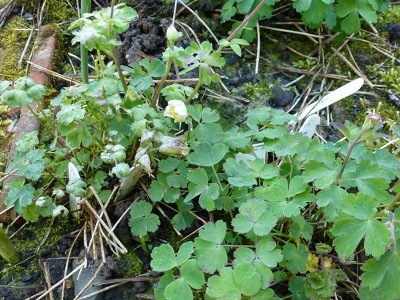 |
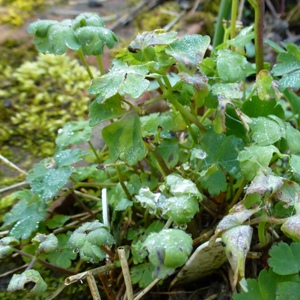 |
| Some leaves are systemically affected as they are produced, being lighter, more upright, having more elongated petioles and curled leaflets. |
|
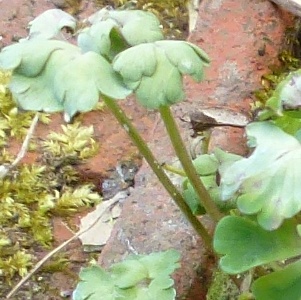 |
| The blighted effect comes from the dying back of affected leaf tissue, plus the curled effect. In fact downy mildew is more closely related to blight than to powdery mildew, eg potato blight. Thank goodness we don't rely on aquilegias as a food crop. |
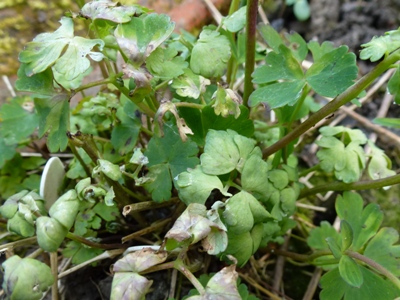 |
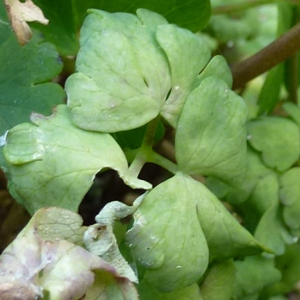 |
More systemically-infected leaves |
||
| Whitish leaves looking delicate, more 'maidenhair-ferny'. |
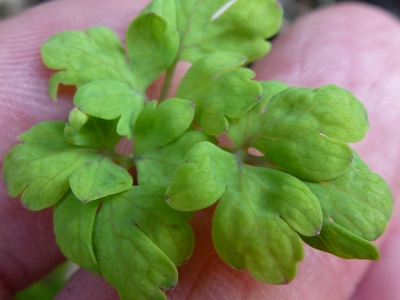 |
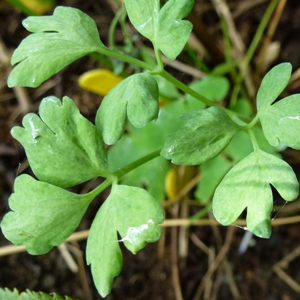 |
| Curled, whitish leaves, later resulting in die-back from the outer margins of the leaflets. |
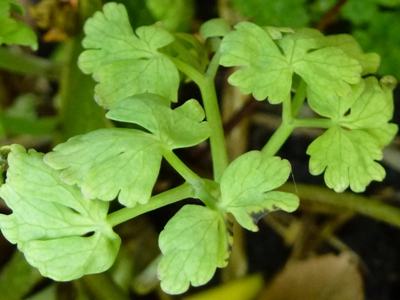 |
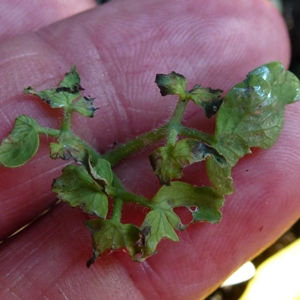 |
| Slugs are drawn to infected leafs, and, although aquilegias are poisonous, graze to get the fungal nutrients. | 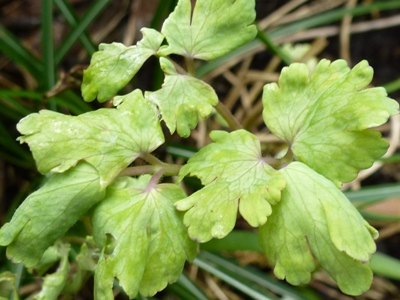 |
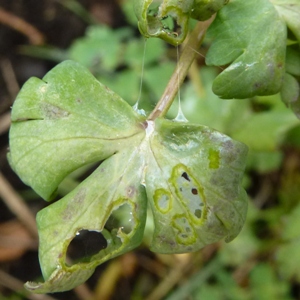 |
| Yes, these sort of leaves will also sporulate on the
underside of the leaf as a downy growth. Although this is the defining sign of downy mildew, it is not always present. It is only produced under the correct moist conditions, and easily flattened out by rain (think of a fluffy thistledown resting on a leaf before, then after, rain!) 2015, I had such downiness from a mild February in some systemically infected plants. |
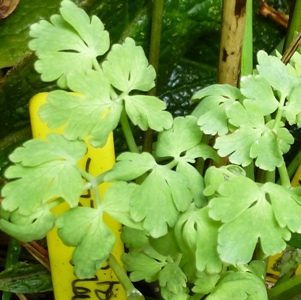 |
|
What to do with DM infected plants |
||
| I think that at this stage it is best to
dig out and get rid of these plants. I believe the infection is in the growing tip (meristem) of the nose of the aquilegia plant. This is the short, almost non-existent, shoot from which the leaves and flower stems arise. |
 |
 |
| Good bye, friend. |
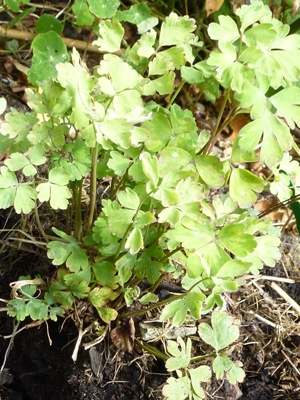 |
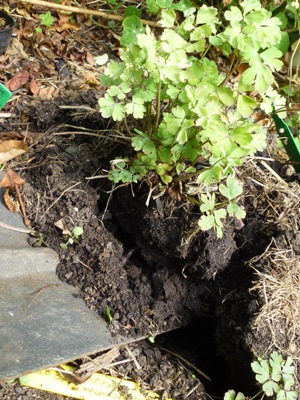 |
| ....and then what? |
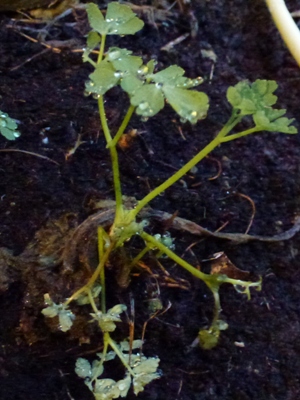 |
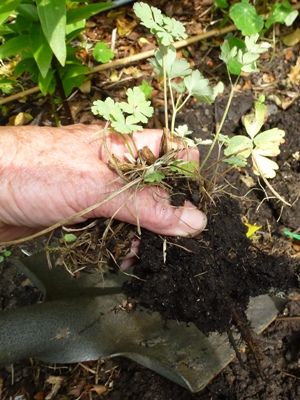 |
| What to do with the removed plants? | If you discover Aquilegia downy mildew in your
Aquilegia plants, it is very important to get rid of
diseased plants, or at least infected leaves, because they will
be infecting your other, healthy Aquilegia plants as
well as contaminating the soil for years (possibly even decades)
to come. The RHS Aquilegia DM page has good advice: Affected plants should be disposed of as soon as possible. Do not compost them. Ideally burn them or bury them deeper than 50cm (20in). Although the spores should not survive the commercial composting used for council green waste collections, it is best to deal with contaminated material within the garden. Last year (2014) I was using the council green waste collections. This year I will try the burial method, I have plenty of soil depth here in my gritty, sandy soil. |
.jpg) |
| SPACE FOR YOU. What are your experiences with downy mildew, and how have you coped (or not coped)? Please email me and if you give your County and town (and, hopefully, photos) I can add the area to the directory I'm compiling of where DM has been found. Thank you. |
||
Experiment: control by leaf-picking |
||
| However, I have also experimented with pulling off such
infected leaves over time, in the hope that the meristem may
recover. It could also be that my premise is wrong, and the growing tip itself isn't infected, instead the baby leaf becomes infected as it grows through masses of spores trapped by the funnel of leaf stems at ground level. The day before I had sprayed with Systhane Fungus Fighter (myclobutanil) (the only time I ever tried it), which has made the leaves look shiny but never had any other visible effect. |
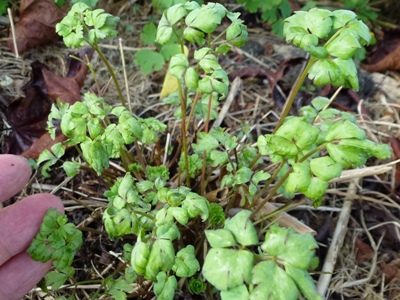 |
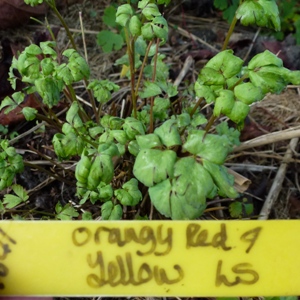 |
| Additionally, old plants of aquilegias have many 'noses'
(growing shoots), and not all of them may yet be infected. Pulling/cutting leaves from infected shoots could, in theory kill that shoot and allow the unaffected ones to continue. |
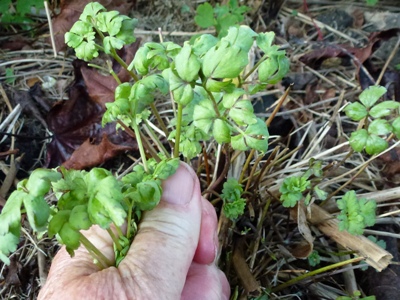 |
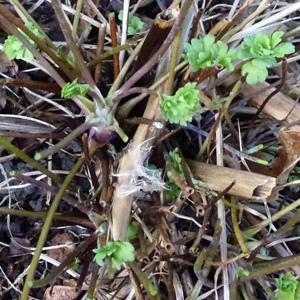 |
| I started early September. Autumn was warm in 2014 so
there's still a lot of active growth to come, as you shall see.
This is 5 days after the above four photos. I crop again. |
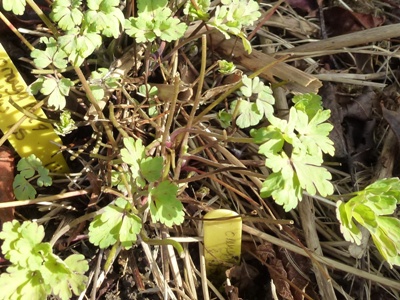 |
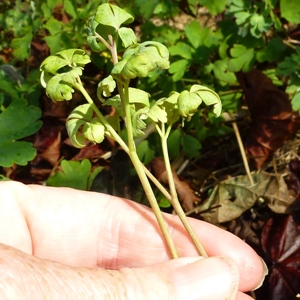 |
| Another 5 days, and a few more systemically infected leaves to pull off. |
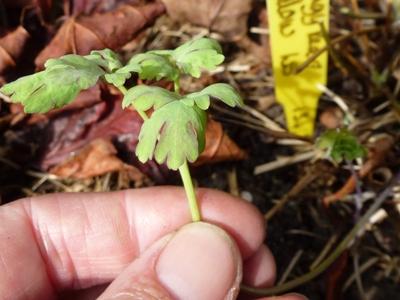 |
|
| 4 days later (2 weeks from first photos), there are just 2 infected leaves to pull away. The rest look ok, although it's not always easy to see infection in small leaves. |
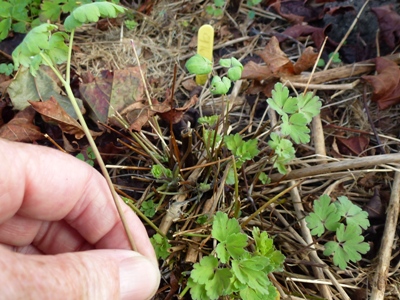 |
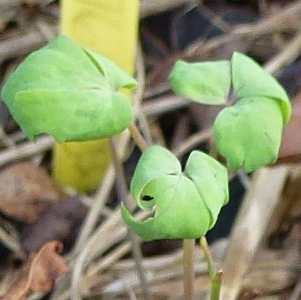 |
| After a total of 29 day (5 days from the last photos) I only have 3-4 infected leaves to pluck. ALL THE REST OF THE LEAVES ARE FINE! |
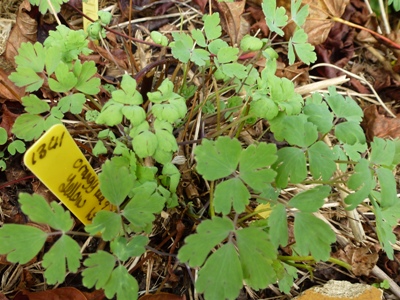 |
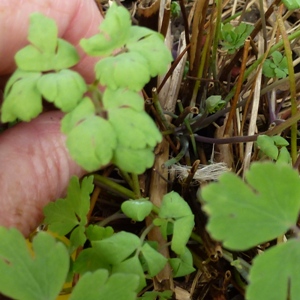 |
| I REJOICE. This plant is indicative of the rest of my garden, by now almost all have been cut back and infected leaves removed. (Many more dug up and discarded) I book a last-minute holiday and go away to relax away from the stress of this season. |
||
| This is 3 weeks after the last photos. I un-rejoice. However, lets look at this again. This is NOT SYSTEMIC / meristem infection, which was the more worrying occurrence at the start. Instead, all my lovely, healthy new leaves have been infected by, presumably, resistant oospores from the soil. Or, less likely, by sporulation from nearby leaves. Mulching could have helped, but aquilegias do not like mulch over their growing tips. |
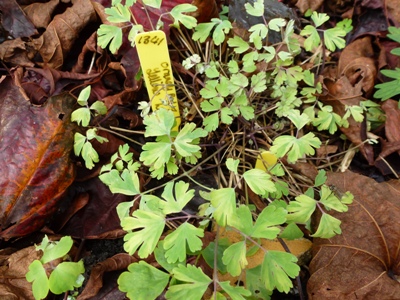 |
|
| Is there a bright side? Well, the leaves are very pretty, if you don't know that they are infected! It's why some gardeners have a conditioned aversion to variegated leaves. It has given me some photos of very clear-cut infection. Usually the yellowy patches are not so defined as this. Why? Possibly the genetic make-up of this hybrid, or the effect of autumn temperatures? |
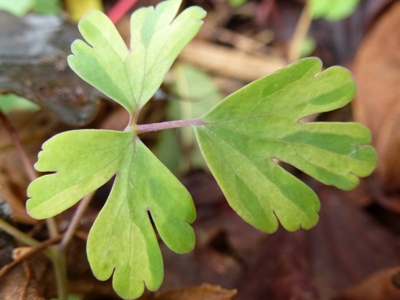 |
|
| Nearly a month later, 10th November, and just about no new
leaves. Winter arrives. The close-up shows the bare tips of 2
the noses / shoots of the plant, that don't look very hopeful. I shall await the spring to find the fate of this plant and the final result of my experiment. |
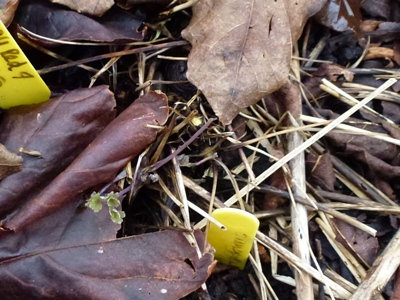 |
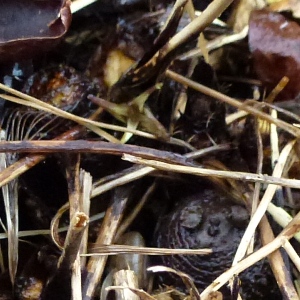 |
Experiment: control by leaf-picking 2 |
||
| This is a plant of Hybrid C. Again, I
had sprayed with Systhane Fungus Fighter (myclobutanil)
the day before. Here, on the 6th September, we have taller, mature leaves that have become infected by spores... |
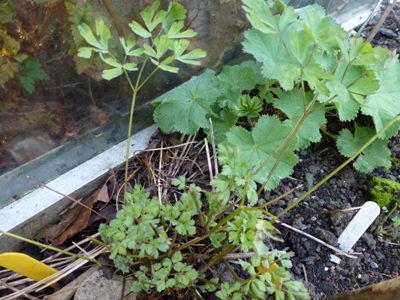 |
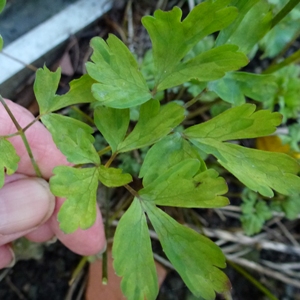 |
| .... as well as new, systemically, meristem infected leaves
at the ground level. All are removed. |
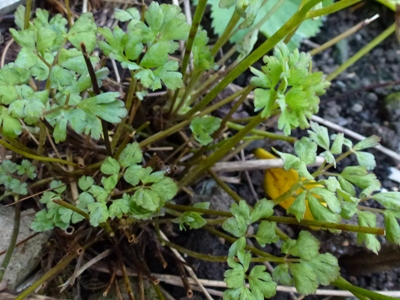 |
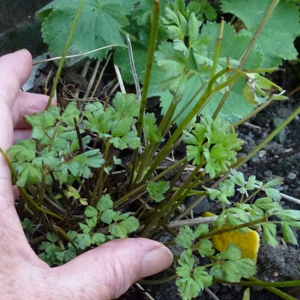 |
| 5 days later, there is just one leaf on whole plant. It is systemically infected, and so picked. |
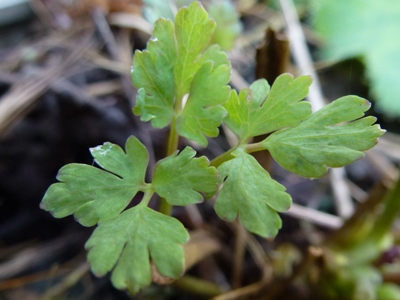 |
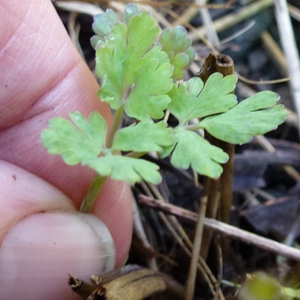 |
| Another 5 days sees many new leaves emerge, and picked off if infected. |
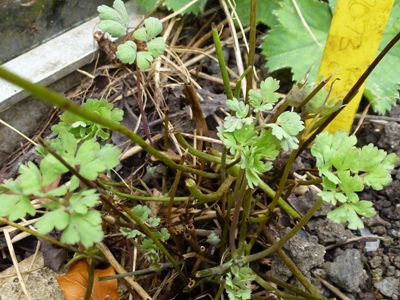 |
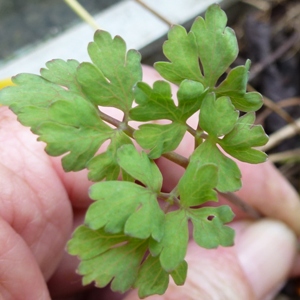 |
| Another 4 days, so 2 weeks from the first picking, ALL new
leaves are seen to be systemically infected, and removed (some
very small ones left, as unsure of condition). The photo shows all the left-behind petiole-bases (ends of leaf stems) which hadn't been very obvious when I actually picked the leaves. Removal of as much of the petiole as possible is likely better hygiene practice, both as the remains could harbour old spores, but also could actually be producing new spores. |
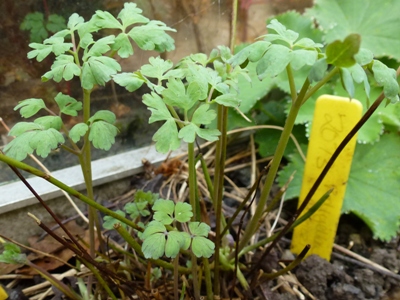 |
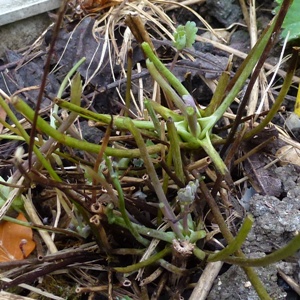 |
| Day 29 from start, ALL new leaves produced continue to be infected, and picked off. |
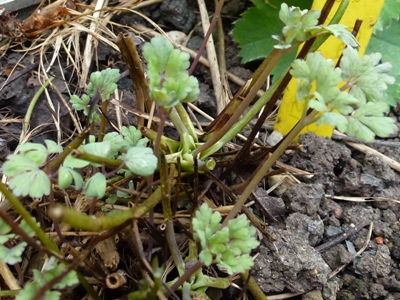 |
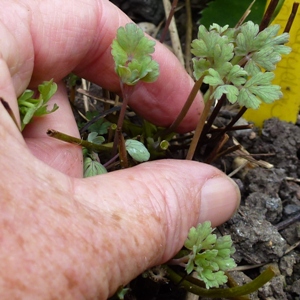 |
| Another 3 weeks, mid-October, has seen very little growth. But that, too, needs to be removed. |
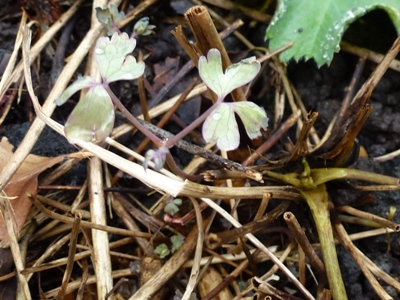 |
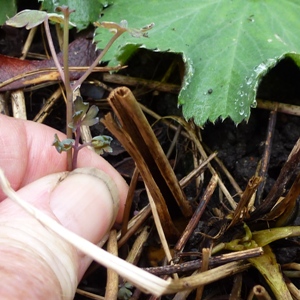 |
| It's the 10th November, again all top growth is removed. |
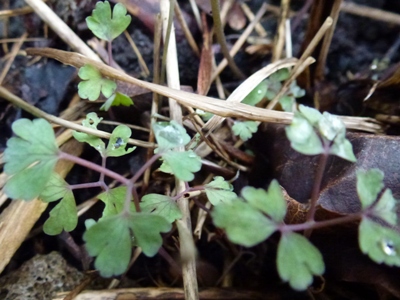 |
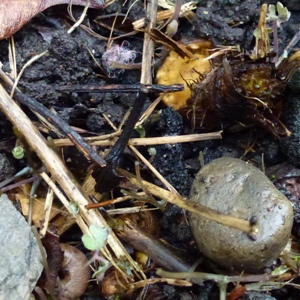 |
| I think this is one very infected and exhausted plant. Will it survive winter? Will it have infection present as it starts into growth? This beautiful flower is what I think I have now lost...... |
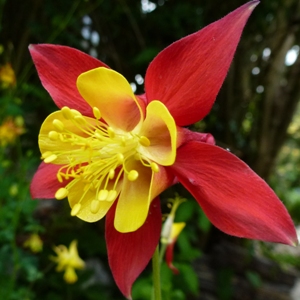 |
|
| I have a full webpage on signs to look for as your infected plants start into growth in springtime. | ||
| Back to top |
Copyright Carrie Thomas 2014. Web wizardry by Trevor Rees. All rights reserved.